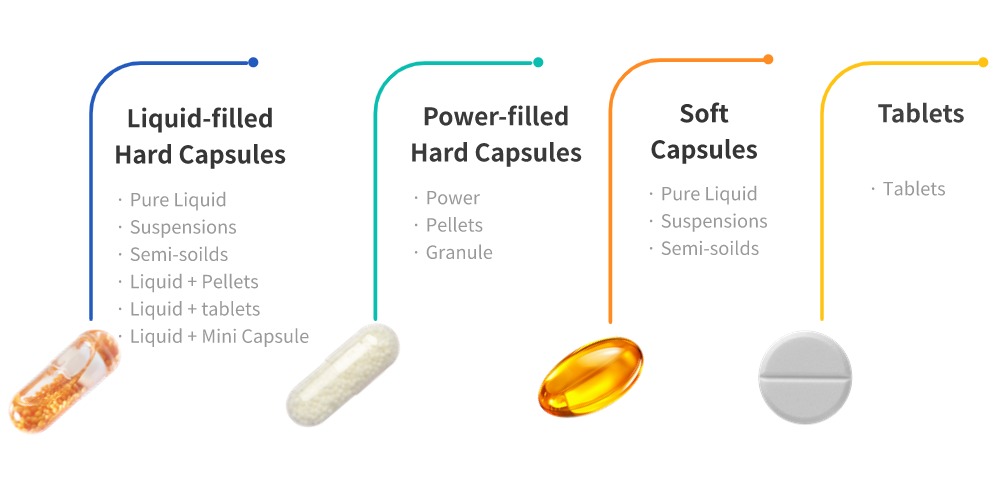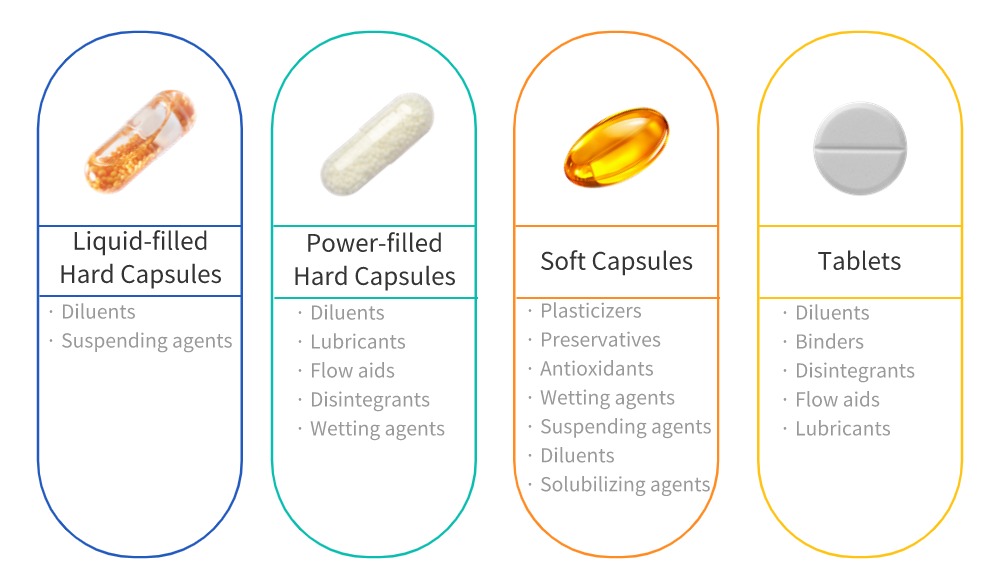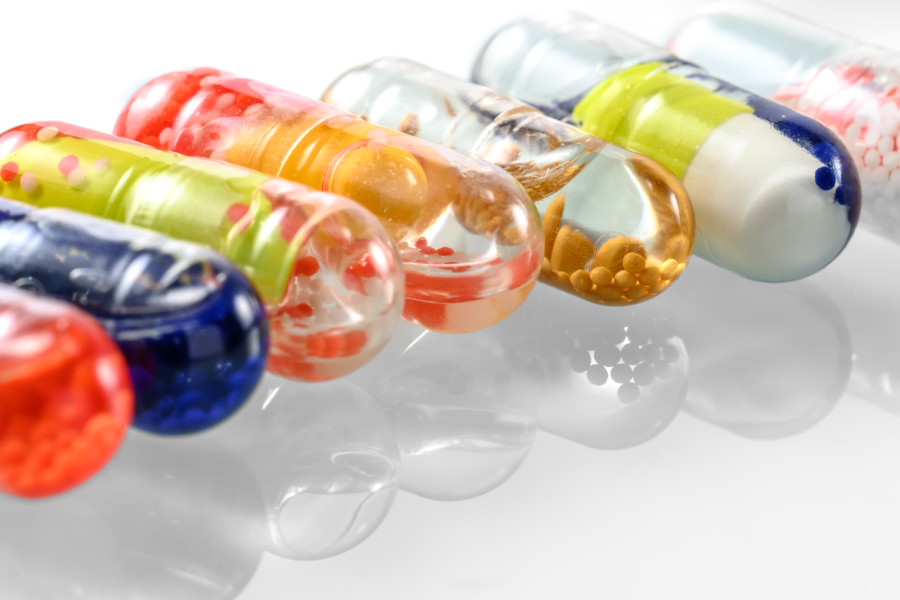What Are Liquid-filled Hard Capsules?
Capsules refer to solid formulations in which raw pharmaceuticals or appropriate excipients are filled into empty capsules or sealed in soft capsule materials. Generally, they can be divided into hard capsules and soft capsules. In traditional formulation processes, hard capsules refer to those using suitable formulation techniques to make uniform powders, granules, pellets, etc., from raw pharmaceuticals or with suitable excipients, which are then filled into empty capsules; soft capsules refer to those where a certain amount of liquid raw pharmaceuticals are directly sealed, or solid raw pharmaceuticals are dissolved or dispersed in suitable excipients to form solutions, suspensions, emulsions, or semi-solids, and then sealed in soft capsule materials.
In formulations, some drugs have characteristics such as poor solubility, low melting points, low dosage or potent drugs, and sensitivity to moisture and heat. These properties pose greater difficulties in conventional formulation processes for oral solid dosages like capsules and tablets, leading to unstable drug quality. With the development of formulation technologies and equipment, liquid-filled hard capsules have emerged.
The contents of liquid-filled hard capsules come in three forms: ① oily or lipid substances; ② effective ingredients placed within an oily or lipid carrier; ③ a combination of oily or lipid substances with traditional hard capsule contents, achieving a composite filling of liquid with powders/pellets/tablets/capsules. Thus, liquid-filled hard capsules refer to capsules where solid raw materials are dissolved or dispersed in suitable oily or lipid substances to form solutions, suspensions, or semi-solids, filled into empty hard capsules. They can also involve composite filling of an oily or lipid substance with pellets, mini-capsules, or tablets within the empty hard capsules. Compared to other oral solid dosage forms, liquid-filled hard capsules offer a more diverse range of filling options.

Currently, liquid-filled hard capsules can integrate different dosage forms into a single capsule; unlike traditional hard capsules, liquid-filled hard capsules can achieve the following diverse filling forms:
- Pure liquid, a single liquid or a mixture of miscible different liquid;
- Suspensions, which allow the dispersion of powders in a liquid medium;
- Semi-solids, by heating treatments, viscous liquid or semi-solids with poor flowability at room temperature can be converted into liquid with better flow;
- Solid-liquid composites, which can achieve combinations of liquid + pellets, liquid + tablets, liquid + mini capsules within a single capsule, enabling ① incompatible drugs to coexist in the same capsule; ② drugs with different release timings to coexist in the same capsule. It can also provide consumers with a unique visual effect.
Compared to traditional capsule forms, liquid-filled hard capsules have distinct characteristics and broad adaptability. They are highly transparent and have excellent heat resistance, moisture resistance, sealing properties, and toughness. Considering the formulation process characteristics of liquid-filled hard capsules, they are mainly used for insoluble drugs, low melting point drugs, low dosage or potent drugs, moisture and heat sensitive drugs, sustained-release drugs, targeted release drugs, easily oxidizable or specially odorous drugs, traditional Chinese medicines, and health products. Additionally, due to the unique formulation characteristics of liquid-filled hard capsules, they can, to some extent, replace some soft capsule products.
The advantages of liquid-filled hard capsules are primarily reflected in three aspects: ① formulation ingredients, simpler and safer; ② processing flow, more compatible and user-friendly; ③ product quality, more stable and effective.
Advantage 1 – Formulation Ingredients: Simpler and Safer
Liquid-filled hard capsules dissolve or disperse solid raw materials in appropriate excipients to form solutions, suspensions, or semi-solids, which are then filled into empty hard capsules. They can also involve filling liquid combined with one or more types of small pellets, mini-capsules, or tablets into empty hard capsules.
In terms of formulation components, liquid-filled hard capsules are a “minimalist.” They hardly involve the chemical synthetic excipients used in other oral solid formulations. In contrast, other common oral solid formulations require a significant amount of excipients to ensure formulation quality and manufacturing processes.

- Powder-filled Capsules commonly use excipients such as diluents, lubricants, flow aids, disintegrants, and wetting agents.
- Soft Capsules commonly use excipients such as plasticizers, preservatives, antioxidants, wetting agents, suspending agents, diluents, and solubilizing agents.
- Tablets commonly use excipients such as diluents, binders, disintegrants, flow aids, and lubricants.
- Liquid-filled Hard Capsules commonly use excipients such as diluents and suspending agents.
From the usage of excipients in the different oral solid dosage forms mentioned above, the excipients used in liquid-filled hard capsules are the safest and simplest. They aim to minimize the bodily burden while ensuring effectiveness.
Advantage 2 – Processing Flow: More Compatible and User-Friendly
The production process for liquid-filled hard capsules can be divided into several stages: mixing, filling, sealing, drying, and packaging.

Compared to other solid dosage form processes, the production process for liquid-filled hard capsules can achieve the following:
- Customized production in small batches;
- Simplified manufacturing process with accurate dosing;
- Short production cycles, low energy consumption, and reduced operating costs;
- Compared to tablets and powder capsules, there is no dust pollution, making it more environmentally friendly and safer for personnel;
- Compared to soft capsules, it does not use a large amount of lubricants, avoiding pollution to equipment and products, and does not require frequent cleaning;
- Compared to soft capsules, the production process does not generate much oily waste and conveyor belt scrap, which is beneficial for environmental protection;
- Capability to perform composite filling, such as liquid + pellets, liquid + mini-capsules, liquid + tablets, accommodating the needs of common oral solid dosage forms.
Advantage 3 – Product Quality: More Stable and Effective
Due to the simplicity of the formulation components and processing technology of liquid-filled hard capsules, their quality is very apparent. Compared to other oral solid dosage forms, liquid-filled hard capsules have clear advantages in their quality indicators; specifically reflected in aspects of safety, functionality, applicability, and aesthetics:
Safety
- Fewer excipients and processing aids;
- Lower moisture content, beneficial for microbial control;
- More natural and organic components can be used;
- Free from plasticizers, resulting in a low rate of material migration;
- The use of sealing bands not only prevents leaks but also serves as a “tamper-evident” safety measure.
Functionality
- Capsule shell thickness of about 0.1mm, thinner than the 0.7-0.9mm of soft capsules, making the capsules easier to disintegrate and facilitating the absorption of the contents;
- Free from disintegrants, yet the capsule shell can still disintegrate normally to release contents;
- Free from plasticizers, the capsule material does not easily undergo cross-linking reactions during storage, preventing hardening or brittleness of the shell; capsule disintegration performance is more stable.
Applicability
- Processing temperatures up to 60°C;
- More precise low-dose filling;
- Flexible batch customization;
- Single-medium filling or complex combination filling to meet diverse formulation needs.
Aesthetics
- Transparent capsule shells provide a direct view of the contents;
- Color coordination of sealing bands can offer more innovative visual effects;
- The choice of transparent sealing bands does not impact the product’s appearance.

With advancements in formulation technology and the development of accompanying equipment, liquid-filled hard capsules provide more options for solid dosage forms. They allow for the combination of solid (pellets, tablets, capsules) and liquid formulations within the same dosage form and can incorporate materials that might otherwise have compatibility risks or require different release timings in the same dosage form. In terms of formulation ingredients, liquid-filled hard capsules are simple and safe, minimizing the use of synthetic chemicals, preservatives, plasticizers, disintegrants, etc., thereby reducing the burden of absorption and conversion on the human body. In the formulation process, liquid-filled hard capsules offer better compatibility while meeting formulation requirements and exhibit clear advantages in environmental, health, and safety (EHS) aspects compared to other solid dosage forms.